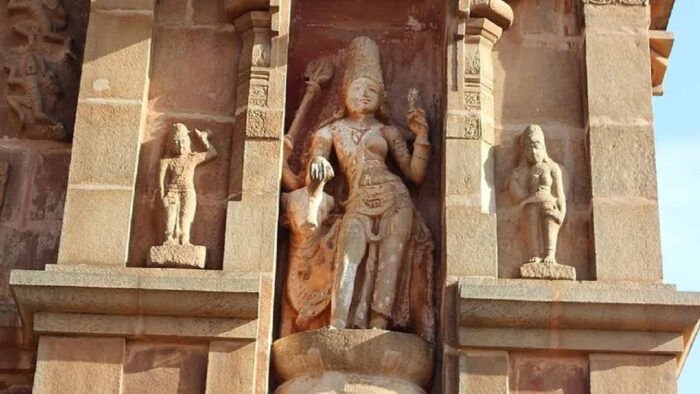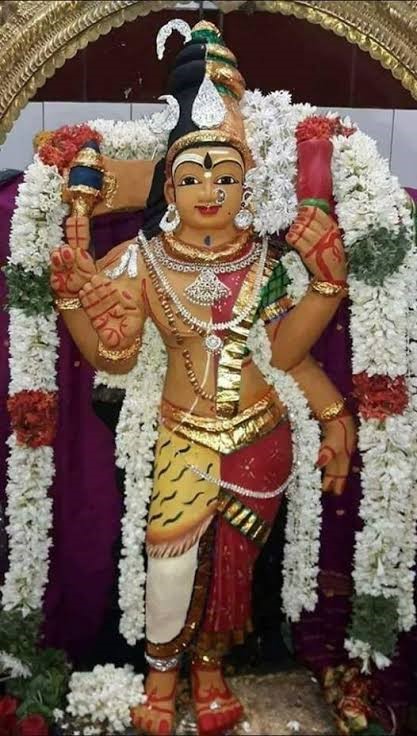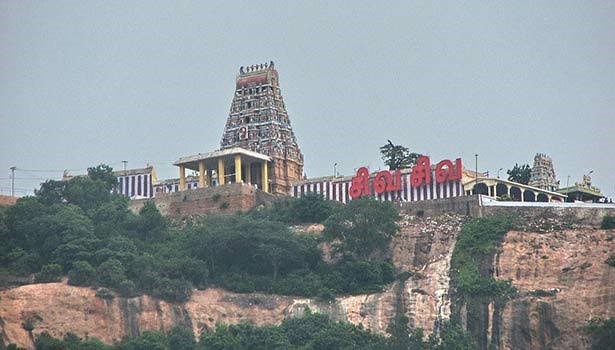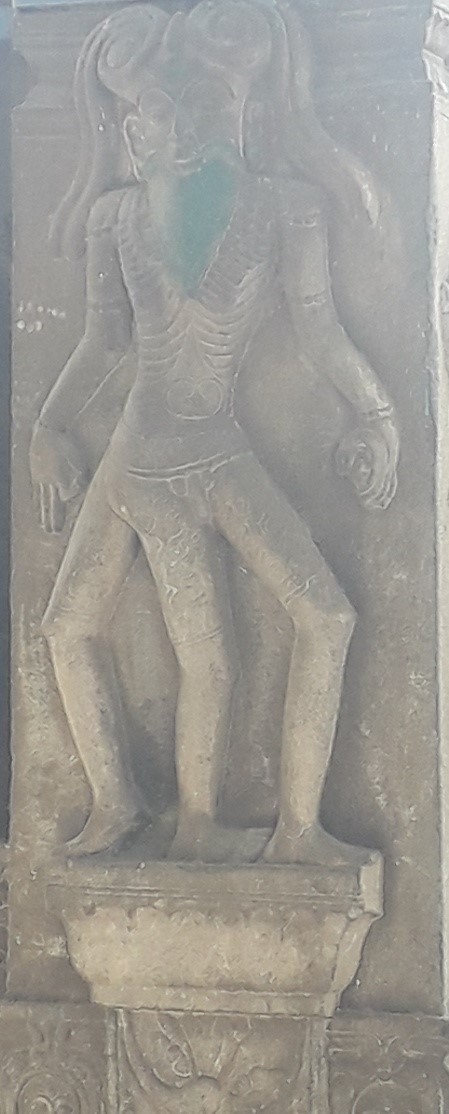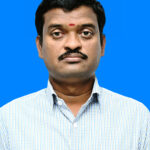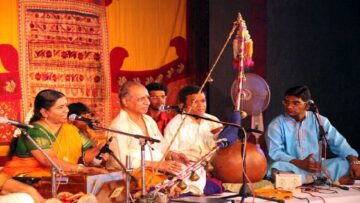Abstract
In Hinduism there are different forms of Gods and each of them represents a particular aspect of the Supreme Being. Mother goddess is the divine creative feminine force, known by us as Shakthi. She is the progenitor of all gods. She is the kinetic energy of the supreme Brahman. Hindu literatures portray the Sivasakthiswaroop as the most powerful one. This article delves into Arthanareeswara worship and literature associated with it, which is the best example of gender equality in Hindus.
Introduction
According to the Sanatana Dharma the ultimate goal of human life are the four purusharthas, namely dharma, artha, kama and moksha. Hindu scriptures impart knowledge equally to men and women to attain all these and when compared to any other religion, women can get salvation directly in this birth itself. In our culture all life forms are equal in the sense that all of them are receptacles of aatma.. Aatma is dehi, resident of the body, deha. Everyone’s dehi is the same but our deha is different. So like various plants in the forest, every human is also unique although commonalities allows them to be categorized. These categories can be psycohological, physiological or social. But the most important category is gender (male, female, others). Just as every plant has different food requirements, different humans have different needs. Just as in a garden some plants are favoured over others, in society too some humans are given greater merit than others – for example in some societies, an intellectual person is valued, in some the rich while in others men may be given more prominence and yet in another it may be the reverse. Thus, different societies value different aspect of our body. In Hinduism a god is seen as incomplete without a goddess. Shiva is incomplete without Shakthi, Krishna without Radha, Rama without Sita. Likewise, householder was seen as a balancing force in society and not the single men or single women.
The Feminine in Scripture
Since ancient times, female figures have featured prominently in Hinduism, both in human and divine form. Many of the sages associated with the realization and authoring of the Vedas with women. The Rig Veda contains hymns composed by women such as Lopamudra and Maitreyi. Sage Gargi appears in the Brihadaranyaka Upanishad where she poses a volley of questions to Sage Yajnavalkya on the nature of the soul, and teases out core teachings from Yajnavalkya that a courtroom of male philosophers failed to. Hindu epics such as the Mahabharata and Ramayana idealize women, embodied by depictions of Draupadi, the wife of the five Pandava princes in the Mahabharata, and Sita, the wife of Prince Rama in the Ramayana. There are also many Puranic texts which elucidate the stories and symbols of solely the feminine divine. Stories and prayers from the Devi Mahatmyam and Devi BhagavataPurana, for example, are the subject of art, poetry, dance, drama, and worship. Of course, consorts of male Gods such as Vishnu and Shiva, also figure centrally in respective Vaishnava and Shaivite scripture.
Arthanareeswara for gender equality
(Figure 1: Depiction of Sivashakthi as Arthanareeswara)
The concept of Arthanareeswara has a profound inner meaning. The deity symbolizes the optimal balance of the male and female energies in this world and also indicates that they are essentially inseparable forces, which are complementary to each other and must work together to maintain equilibrium. It shows the unity in the opposites of Purusha and Prakriti.
Purusha is the passive force of the universe, while Prakriti is the active, dynamic force. Both these forces must embrace and fuse with each other to generate and sustain the universe. This idea is also brought forth by the union of Linga of Shiva and the Yoni of the Devi, thus giving rise to the birth of the entire cosmos. The concept of Arthanareeswara is also suggestive of Kama or lust, which gives rise to procreation.
As far as Sanskrit literatures are concerned, famous devistotras include lalithasahasranama, soundaryalahari, mookapanchasathi, shyamalatandakam are predominantly recited by sakthas. Shakthas believe that spiritual perfection and attainment of liberation is mainly through devi worship. In Mahabaratha we have durgastotras and the Aryastava portraying devi with more power.
Mahishasuramardhini or the slayer of demon Mahisha is the common motif of representing the devi from Devi Bhagawatam. We can find this in several other heritages sites across the country. Pallava king Narasimhavarman constructed famous cave temples in Mahabalipuram. She is worshiped as Meenakshi in Madurai, Kamakshi in Kanchipuram and in many more forms.
Adishankara wrote some of the most seminal works of Vedic philosophy. He traveled across the length and breadth of India. He composed several compositions on various Gods. One of the most famous ones is Mahishasur Mardhinistotram. It portrays the victory of devi over demon representing the women empowerment.
Devi Mahatmiya gives much importance to Parasakthi. In various stotras she is considered to be in different forms, namely mother, sister, consort of Siva or a daughter aspect. According to lalithasahasranama, which is considered to be jewel of sakthi worship, Hayagriva, the horse faced god, is considered to be the guru of sakthas. He performed Devi worship in a strict manner to get liberation. Lopamudra, wife of sage Agastya approached Hayagriva and got initiated into the sakthi path by Hayagriva. He then spread the Lalithasahasranama to all. In almost every temple Lalithashasranama is recited by sakthas. The goddess is worshiped in mantra, yantra and tantra. Mantra or the spoken word is used for chanting her name. Lalithasahasranama, which gives account on 1000 names of Devi, she is referred to as sadhasivakudumbini, sivasakthiikkyaswaroopini etc., indicating gender equality. Many Tamil literary texts are available in praise of the devi, chief among them are Silapathikaram, Abiramianthathi, Madurai Meenakshiammaipillaitamizh, Meenakshiammaikuram, etc.
Abiramianthathi is one such Tamil poem written by Abiramipattar in praise of goddess Abirami whose temple is located in Thirukadaiyur. Even though this is related to sakthas, in almost all poems she is portrayed as the consort of Lord Shiva. The following song by Pattar about vamabaga is an excellent example.
அதிசயமானவடிவுடையாள்
துதிசயவாணனசுந்தரவல்லி
பதிசயமானதுஅபசாயம்மாக
மதிசயமாகஅன்றோவாமபாகத்தைவவ்வியதே.
In Soundaryalahari Sri Shankaracharya praises the sivasakthiswaoopa and explains the importance of sakthi.
Śivaḥ śaktyā yuktoyadibhavati śaktaḥ prabhavituṁ
nacedevaṁ devonakhalukuśalaḥ spanditumapi|
Atastvāmārādhyāṁ hariharaviriñcādibhirapi
praṇantuṁ stothuṁ vā kathamakṛtapuṇyaḥ prabhavati||
(Shiva is able to create this world only along with Shakthi.Without her, even an inch he cannot move, so how can one who does not do good deeds or one who does not sing your praise become adequate to worship you, Oh, goddess of mine, who is worshipped by the trinity).
Purusha is the passive force of the universe, while Prakriti is the active, dynamic force. Both these forces must embrace and fuse with each other to generate and sustain the universe. This idea is also brought forth by the union of Linga of Shiva and the Yoni of the Devi, thus giving rise to the birth of the entire cosmos. The concept of Arthanareeswara is also suggestive of Kama or lust, which gives rise to procreation.
Concept of Arthanareeswara
The concept of Arthanareeswara indicates that “totality lies beyond duality” and the essentially equal nature of both the masculine and feminine energies. It talks of both being part of the Supreme Being, being two equal parts, making the whole. Shiva’s half part holding a rosary indicates asceticism, while Parvati’s half holding the mirror is an embodiment of the highly material and illusory world. The fusing of these two opposites indicates that both the material and spiritual spheres have to coexist in one’s life, for it to be complete. Shiva and Shakti are inseparable and interdependent. This indicates that both these opposing forces are one and the same and cannot be regarded as two individual identities. Many cultures of the world also believe that hermaphrodite icons such as the Ardhanarishvara also symbolize fertility and limitless growth. Shiva embracing Parvati is associated with the boundless reproductive ability of Mother Nature herself. The supposedly opposing forces then become so non-dual, that it would finally become impossible to locate the masculine in the feminine and vice-versa. Usually, the Shakti half is located to the left of the Arthanareeswara and Shiva is shown on the right side. Traditionally too, the wife is seated to the left of the husband and hence, she is known as “Vamangi”. The right side is often associated with masculine traits and cerebral functioning such as logic, direction, systematic thought and so on, as also with valour and related traits. The left side is related to the heart, therefore is also associated with typical feminine characteristics such as creativity, intuition and so on. The Vamabhaga or the left side is also indicative of being the “inferior” side, embodying dependence in a relationship, while the right is considered to be the more dominant side, being “superior” in bhoga or material indulgence, which is usually symbolized by the female form. Shiva is regarded as the dominant half. That is probably why Nandi, Shiva’s vahana is almost always shown as the vahana for the Ardhanarishvara as well and not the Devi’s lion. Shakta schools consider the Devi the more dominant half and that is why she is also portrayed as being on the right side of the male half-form of Shiva.
Referring to Lord Shiva’s Arthanareeswara form – half male, half female, Kovind said both masculine and feminine aspects need to be in balance for a human personality and for a society to prosper.
Arthanareeswara temple, an ancient Hindu temple, in Tiruchengode, Namakkal district of Tamil Nadu, is dedicated to a unique god – Shivashakthi who is half-male and half-female, symbolic of gender equality. It is a rare form of God in the Hindu pantheon enshrined as the principal deity. Tiruchengode, one of the most important pilgrimage centres in South India, has as many as 108 Theerthangal or water bodies and among them, the most important one is Ammaiappar Theertham at the feet of Lord Arthanareeswara temple. In the ancient work of Silapathikaram the place is mentioned as ‘Neduvelkundru’. MuttuswamiDīkshitar, a famous trinity of Carnatic music, wrote compositions in praise of Arthanareeswara. Tamil saint Sambandar composed the Tiruneelakanda Pathigam here, to help devotees get rid of ailments. Saint Arunagirinathar also composed ”Thirupugazh” on Lord Subramanya here on the hill. The deity here is also known as Madhorubagan and Ammaiyappan (mother-father).
Atop the sacred hill (about 650 ft. high and a climb of 1156 steps; total height of the hill is 2000 feet from mean seal level, covering 350 acres), the temple is dedicated to Arthanareeswara, a foot tall idol and Lord Shiva is known as Maathoru Paagar and Ambal, his consort, is known as BaagampiriyaalAmmai. Though sanctum- garbagriha faces the West, the main entrance to the temple is in the South. The compound wall of the temple has a length of 260 feet from east to
(Figure 2: Temple atop a hill dedicated to Madhorubagan and Ammaiyappan (mother-father))
west and 170 feet from north to south and height of 16 feet. The main tower (84.5 ft tall gopuram) has 5 tiers on the north side and is called ThirumalaiGopuram built by Sri Krishna Devarayar in 1512 and the basement (kalkarar) was built during the reign of SadasivaMaharayar.
Legends related to Arthanareeswara
According to the belief of the people, it was AdiKesavaPerumal, a form of Vishnu enshrined here, who instructed Gowri to perform the KedaraGowriVratam. The Goddess did this vratam (austerity) and united with Shiva as Arthanareeswara, an embodiment of male-female equality, implying Shiva cannot function alone without Sakhti (goddess).
In another legend, Bhringi is an ardent devotee of God Shiva and a Rishi, who is well known as a member closely associated with God Shiva’s family and is also one among the chief ganas is portrayed with three legs and skeleton-like body.
(Figure 3: Rishi Bringi)
The Birth of Bhringi
The birth of sage Bhringi has been linked to Kumara Sambhavam (which explains the birth of Kumara or Murugan). According to this, the sage has been born from some part of tejas of God Shiva which fell on Giriprastha Mountain and lead to the birth of Mahakala (one among the Dwarapalakas) and sage Bhringi.
Another version of his birth is related to the demon Andhaka, who later became the devotee of God Shiva with name Bhringi.
Story of Rishi Bhringi
The story of Rishi Bhringi is absolutely one of the most interesting ones ever. His devotion is ultimate and he had been richly praised in several scriptures.
His story explains the importance of Shakthi (Parvati) and also teaches that Shiva and Shakthi are the same and inseparable.
Once Bhringi was so immersed in God Shiva’s devotion that he only offered prayers to him and totally ignored Goddess Parvati who is an inseparable part of Shiva himself.
One day when Bhringi along with several sages visited Mount Kailash to pay respects, all the sages paid their respects to both Shiva and Parvati by circumambulating (pradakshina) and bowing to Shiva and Parvati. However, Bringi only circumambulated around Shiva which infuriated the Goddess who decided to teach him a lesson. So the next time when Bhringi came to offer his prayers, Goddess Parvati sat on the left lap of the God Shiva to prevent him from circumambulating only around Lord Shiva. Seeing this, Bhringi took the form of a bee (some say a small bird) and performed pradakshina only around Shiva’s head and left Kailash. Next time when he visited Kailash, both the god and goddess merged together as Arthanareeswara (the form representing Shiva’s half as Shakti). Goddess Parvati thought that he has no option but to do the pradakshina around them. However, Bhringi transformed into a small bee and made a hole in between them and circumambulated only around Shiva.
Angered by this incident and Bhringi’s steadfastness, Goddess Parvati said, ‘O Bhringi, your acts might be welcomed by your father (Shiva) but not me. I have tried to explain to you in several ways that we both are same, but you ignored it. If you think you only need your father, then why do you need Shakti in you? Hence, I am going to take away that part from you. Thus, the rishi had lost his blood and flesh and left with a bare skeletal form. Seeing Bhringi in such a difficult situation where he was unable to support himself, Shiva granted a third leg (some say even third hand too) to attain equilibrium and support himself and at the same time not to revoke Parvati’s sayings and to make him understand that they both are same. Bhringi then realized the fact that Shiva and Shakti are one and apologized to Goddess Parvati for his actions. Seeing the merciful nature of the God Shiva for granting a third leg, Bhringi danced out of joy and praised both the god and goddess.
Iconography
Bhringi is normally depicted as a rishi with three legs, pointed beard and having a skeleton-like body. He can be distinguished among the Shiva parivara mostly by his skeletal form.
However, as an utsavavahana, he is represented as a young person with four arms in which the upper two holding a trident and a damaru and the rest two hands depicted as showing upwards. Some sculptures even depict Bhringi as one with three hands and three legs. In the dancing form, he is usually depicted holding a whip or stick to make the sound to start and stop the tandava dance.
Bhringi and Kashi
Poet Srinadha in his Book Kashi Khandam had explained the role of Bhringi as the one who removes the fear and applies the Vibhuthi as Tripunda on the forehead of the person near to his final journey in Kashi.
(Figure 4: Iconographic depiction of Bhringi)
His role in Shiva’s tandava
This sage is also given great importance during the Shiva Tandava where he has all the power to instruct the Great God himself when to start and stop the anandatandava dance. This explains the importance given to the devotees of god Shiva.
His importance during the Shiva Tandava dance is also explained by the Adi Sankaracharya in Shivanandalahari (stanza 51) saying that
‘BhringhiichanatanothkatahKaramadi-graheesphuranMadhava’
explaining that Shiva obeys the orders of Bhringi during the tandava dance..
Conclusion
The mother’s grace is boundless. Her mercy is illimitable. Her knowledge is infinite. Her power is immeasurable. Her glory is ineffable and her splendor indescribable. She gives us material prosperity as well as spiritual freedom. Approach her with an open heart. Be simple as a child. Destroy the egoism, cunningnesss, selfishness and crookedness. Make a self surrender to her. If we worship her with faith and devotion she will definitely give all the things we need in life. The modern misconception of feminism talks about superficial equality between men and woman whereas the Hindu culture aligns more towards ‘liberation’ feminism than to ‘equality’ feminism and while the whole world may talk about women empowerment, truly emphasizing it has always been a part of our cultural ethos,”
References
- Devi Mahatmyam of Markandyapurana
- Lalithashasranama of BrahmandaPurana
- Abiramianthathi by abiramipattar
- SoundaryaLahari by Adishankaracharya
- Bhattchacharya, N.N., The Indian Mother goddess, New Delhi, 1977
- Thiruvalangadu copper plates discovered in 1905C.E
- Thiruchengottupuranam
- Sivanandalahari by Adishankaracharya
Feature Image Credit : istockphoto.com
Watch video presentation of the above paper here:
Disclaimer: The opinions expressed in this article belong to the author. Indic Today is neither responsible nor liable for the accuracy, completeness, suitability, or validity of any information in the article.

